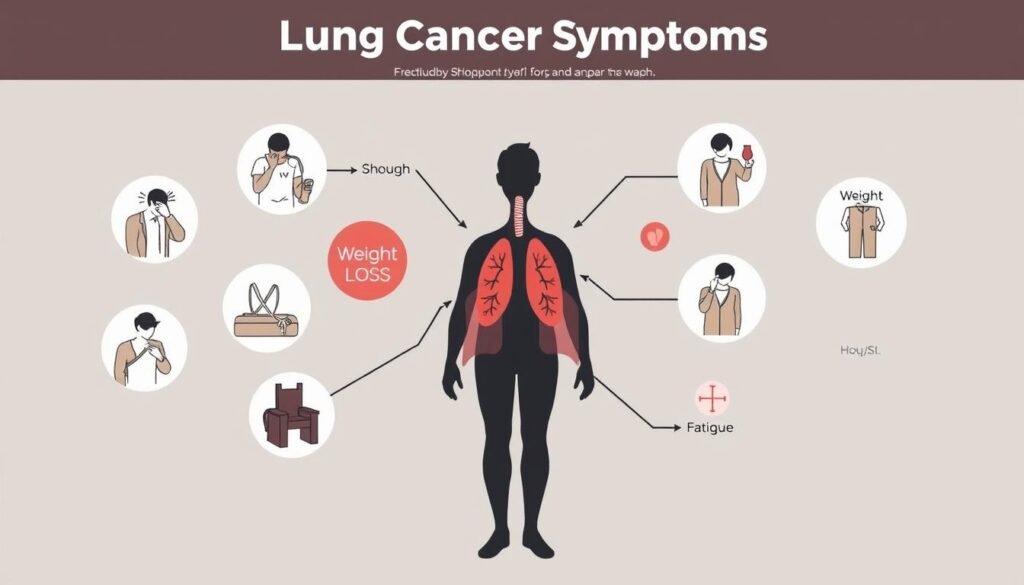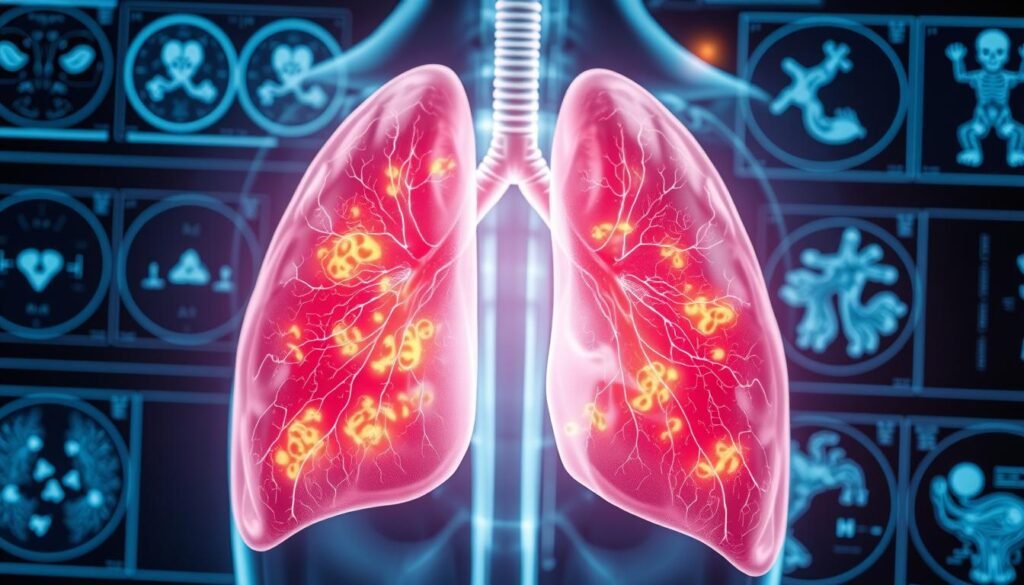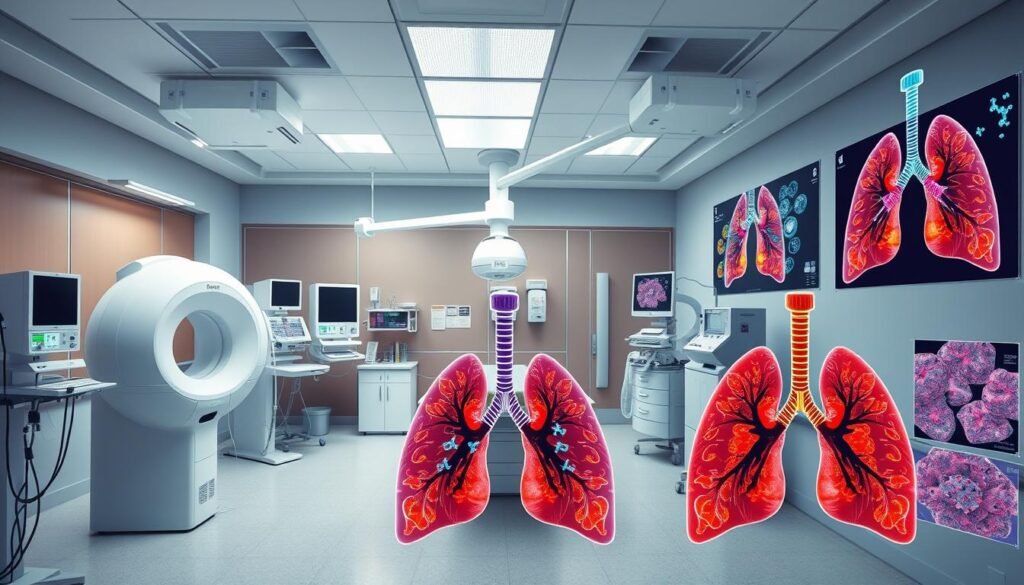Lung cancer is a major health issue worldwide. It accounts for about 11.6% of all cancer cases. It also leads to nearly 18% of cancer deaths. That’s over 1.8 million deaths around the globe each year. RET positive lung cancer is rare but significant. It mainly occurs in adenocarcinoma, affecting 1-2% of patients.
This article explores RET positive lung cancer. We’ll look at RET gene changes, symptoms, and treatment options. Our goal is to improve patients’ life quality. We will cover everything from symptom management to nutritional support.
Knowing about RET positive lung cancer helps in early detection. With the right treatment, patients can see a big improvement in their health.
Key Takeaways
- RET gene rearrangements are mainly seen in adenocarcinoma non-small cell lung cancer.
- Symptoms can be subtle, affecting life quality.
- Modern treatments include drugs like Selpercatinib and Pralsetinib.
- It’s important to manage side effects for better treatment.
- Nutrition is key during treatment, affecting recovery and health.
- There are palliative care options to improve patient life quality.
Understanding RET Gene Rearrangements
RET gene rearrangements, known as gene fusions, are key in fighting lung cancer, especially non-small cell lung cancer (NSCLC). These changes happen in about 1-2% of NSCLC cases. They are more common in young, non-smoking patients. Knowing these lung cancer biomarkers helps doctors diagnose and plan treatment better.
What are RET Gene Rearrangements?
RET rearrangements change the RET proto-oncogene, leading to uncontrolled cell growth. The main partner in lung cancer is the KIF5B gene, found in 70-90% of RET fusion cases. Other partners include CCDC6 and NCOA4, but they’re less common. These fusions are seen more in patients who’ve had radiation therapy, with a 5.4% rate versus 0.4% in others.
Disease Mechanism and Activation
RET activation, from these rearrangements, causes oncogene addiction. This means cancer cells rely on this fault to grow and survive. The RET protein plays a big role in cell growth signals. So, knowing about RET changes helps make drugs that can stop the cancer and help patients live longer. Using precise therapies, like RET-selective inhibitors, has shown better survival rates than older treatments. With next-generation sequencing, we can find these changes. This lets doctors create tailored treatment plans.
Characteristics of RET Positive Lung Cancer
RET positive lung cancer is unique and different from common forms. It’s vital to know who it affects and the risk factors. This helps doctors diagnose and treat it correctly.
Demographics and Risk Factors
This cancer mainly targets younger people, often non-smokers. This is unlike typical lung cancers, which are usually found in older individuals with a history of smoking. Knowing these differences is key for research focused on those with RET changes.
A major study of 5807 patients found only 46 were RET positive. These individuals were usually younger, had a type of cancer called non-squamous, and were non-smokers. This information is important and backed up by strong evidence (p
Common Histological Features
RET positive lung cancer often looks like poorly differentiated adenocarcinoma under the microscope. It can show up as solid, papillary, or lepidic structures. These signs help doctors pinpoint RET rearrangements, which occur in 1–2% of NSCLC cases.
Patients with this cancer type also have a high chance of brain metastases early on. The way this cancer appears helps experts understand and manage it better. For deeper insights into RET rearrangements, check out this study.
Symptoms of RET Positive Lung Cancer
Finding the signs of lung cancer early can really help those with RET positive lung cancer. If found early, treatments work better, and life quality improves. Knowing the early symptoms means doctors can start helping sooner.
Early Symptoms to Watch For
Lung cancer signs often look like other less serious problems. But, keep an eye out for these symptoms:
- Persistent cough: A lasting cough could mean lung cancer.
- Unexplained weight loss: Losing weight without trying could be a sign and needs checking.
- Chest pain: Feeling pain in the chest area might show something serious like cancer.
- Shortness of breath: If it’s hard to breathe, don’t ignore it. It could be important.
Watching for these symptoms is key. Early finding can make treatments more effective and help a lot with outcomes.
Impact on Quality of Life
Lung cancer symptoms can really change someone’s life. People might feel restricted physically and stressed about their health. Facing cancer is hard and can make someone feel very anxious or stressed.
Getting the right support is important. Talking to counselors or joining support groups can help a lot. They support patients through their journey, making their overall life quality better. Dealing with all aspects of the impact helps in caring for RET positive lung cancer patients in a more complete way.

Diagnosis of RET Positive Lung Cancer
Finding lung cancer correctly depends on good diagnosis methods. This is very important for spotting RET rearrangements. Techniques like biomarker testing are key in finding these genetic changes. These are crucial for tackling the disease properly. Nowadays, with lung cancer diagnosis improving, new methods are coming up. These are making it easier to find and treat the disease early.
Biomarker Testing Methods
Biomarker testing has changed how doctors diagnose RET positive lung cancer. Next-Generation Sequencing (NGS) is now the leading way to spot RET rearrangements. This method is better than older ones like FISH because it looks at many things at once. Also, when we can’t get enough tissue samples, tests like liquid biopsies help. These advances are making lung cancer diagnosis quicker and more accurate.
Importance of Early Detection
Finding RET positive lung cancer early is vital for helping patients. When found early, doctors can start specific treatments quickly. For example, targeted therapies, like selpercatinib, have greatly improved the time patients live without the disease getting worse. This compares well to the usual chemotherapy. Only about 2% of people with a certain lung cancer have RET gene changes. Finding these cases early can change how well a person does in treatment. Quick recognition of RET changes leads to better chances of surviving.

Treatment Options for RET Positive Lung Cancer
Finding the right treatment for RET positive lung cancer helps patients a lot. The RET gene plays a big role in cancer. Now, doctors use personalized medicine more. This includes special drugs that the FDA says are good for this cancer.
First-Line Treatments and FDA-Approved Drugs
Doctors often start with drugs called selpercatinib (Retevmo) and pralsetinib (Gavreto). These drugs are approved by the FDA. They work great at stopping cancer growth by blocking the RET pathway. About 1 to 2% of patients with a certain type of lung cancer have RET rearrangements. These patients are often young and nonsmokers. Depending on the cancer, doctors might use other drugs too.
Role of Targeted Therapy with RET Inhibitors
Targeted therapy is key for serious lung cancer. RET inhibitors are a big part of this. They work well and are safe. But sometimes, the cancer finds a way to grow back. That’s why doctors keep looking for new drugs. These new drugs can beat the cancer when it tries to come back.
To keep getting better at treating this cancer, doctors test new treatments. This helps find the best ways to help patients. For more about treatments, visit this resource.

Managing Treatment Side Effects
Patients undergoing RET-targeted therapies might face several side effects. These can impact their health. Knowing these side effects is key to managing them effectively. This knowledge helps patients and caregivers prepare and improve their life quality during treatment.
Common Side Effects of RET Targeted Therapies
RET inhibitors like selpercatinib and pralsetinib are effective against RET-positive lung cancer. But, they have side effects. Common ones include:
- Fatigue
- Nausea
- Dry mouth
- Diarrhea or constipation
- High cholesterol
- High blood pressure
- Swelling in hands or feet
- Skin rash
- High blood sugar levels
- Muscle and joint pain
- Low blood cell counts (white, red, platelet)
Understanding these side effects is crucial for effective management during treatment.
Strategies for Symptom Management
Effective strategies can reduce side effects’ impact. Regular check-ups help spot and treat issues early. Care includes:
- Changing diet with nutritional counseling.
- Getting mental health support to tackle anxiety and depression.
- Joining physical therapy or rehab to boost health.
- Following protocols to quickly manage specific symptoms.
These methods can improve patient experiences and health outcomes during cancer therapy.
| Side Effect | Management Strategy |
|---|---|
| Fatigue | Regular rest periods and gentle exercise |
| Nausea | Medication adjustments and dietary changes |
| High Blood Pressure | Monitoring and lifestyle modifications |
| Skin Rash | Topical treatments and gentle skincare |
| Muscle and Joint Pain | Pain management therapies and physical therapy |
Nutrition Management During Treatment
Nutrition is key when fighting cancer, particularly with RET positive lung cancer. It helps keep strength up, handle side effects, and boost overall health during treatment.
Importance of Nutrition in Cancer Care
Getting the right nutrition is often tough for patients. Weight loss and not getting enough nutrients can really affect their recovery and life quality. Many lung cancer patients face malnutrition, making personalized nutrition plans critical.
Dietary Recommendations for Patients
Eating a variety of healthy foods is vital. This includes fruits, veggies, lean proteins, and whole grains. Staying hydrated is also crucial for good health. And, making meals that meet dietary needs provides necessary nutrients. Here’s what to focus on:
- Consume a variety of colorful fruits and vegetables for different nutrients.
- Eat lean proteins like chicken, fish, and plant-based options to keep muscles strong.
- Pick whole grains instead of refined grains for more fiber.
- Drink plenty of water and other fluids every day.
- Use nutritional supplements if needed to prevent malnutrition.
Good nutrition aims to better treatment results and life quality. Studies show that with nutritional support, patients are healthier and face fewer complications. Spotting symptoms early means quicker nutrition help, improving cancer care results. For info on lung cancer symptoms and early signs, click here.
Palliative Care for RET Positive Lung Cancer Patients
Palliative care is crucial for those with RET positive lung cancer. It aims to lessen symptoms and meet patients’ diverse needs. This care enhances patients’ journeys by focusing on their physical, emotional, and spiritual well-being. Alongside other treatments, it offers comprehensive support.
Understanding the Role of Palliative Care
Palliative care offers customized support for each patient’s unique situation. It helps ease pain, fatigue, and nausea, which can come from the disease or its treatments. By tackling these problems, palliative care greatly improves patients’ quality of life. It provides relief and comfort during a tough time.
Improving Quality of Life through Supportive Care
Supportive care adds more resources to help lung cancer patients feel better. It includes psychological help, nutrition advice, and physical therapy. These services boost resilience and coping skills. Research shows supportive care improves patient results. It’s vital for those with RET positive lung cancer.
Support groups and workshops can also help patients with RET positive lung cancer. These resources assist in managing symptoms and offer a space to share stories and advice. They form a community of support and learning.
| Type of Care | Focus | Benefits |
|---|---|---|
| Palliative Care | Symptom management and emotional support | Improved quality of life, reduced distress |
| Supportive Care | Resources for coping, nutritional, and psychological support | Enhanced patient outcomes, community support |
Conclusion
RET positive lung cancer is a unique kind of non-small cell lung cancer. It makes up about 1%-2% of cases. There’s a need for special methods for diagnosis and treatment. These focus on the RET gene rearrangements that affect treatment choices.
RET changes tie closely to specific histological features and patient demographics. Knowing these can greatly help in improving outcomes. It guides to better treatment options.
It’s key for patients with RET positive lung cancer to get a wide range of support. This should include medical care, nutritional advice, and palliative care services. Such support can make life better during treatment.
Managing symptoms well is key. So is using targeted treatments like RET inhibitors. Both are important in dealing with the physical and emotional issues patients face.
In summary, RET positive lung cancer is challenging but there’s hope. Advances in testing and targeted treatments are promising. Ongoing research and clinical trials are essential.
They help find the best treatments. It’s important to have a strong support system for patients. Putting patients first can change their cancer journey for the better.